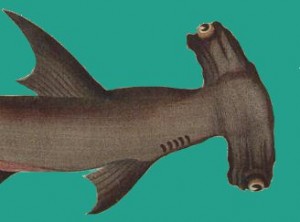WildEarth Guardians submits petition to list the great hammerhead shark under ESA
 Press Release
Press Release
WildEarth Guardians
December 20, 2012
—————————
Advocates Seek Endangered Species Act Listing for Imperiled Hammerhead Sharks
Great Hammerheads Threatened by “Finning,” Pollution, Habitat Destruction
Contact: Taylor Jones (303) 353-1490
Washington, DC –WildEarth Guardians submitted a petition to the National Marine Fisheries Service (NMFS) this week seeking to list the great hammerhead shark (Sphyrna mokarran) as “threatened” or “endangered” under the Endangered Species Act (ESA).
“Sharks are the wolves of the sea, and like wolves they are heavily persecuted,” said Taylor Jones, Endangered Species Advocate for WildEarth Guardians. “If we want to save the top predators in our oceans, we need to protect them under the Endangered Species Act.”
The hammerhead’s name describes its characteristic elongated, flattened head. The great hammerhead shark is the largest of the hammerhead species, with adults averaging over 500 pounds and reaching lengths of up to 20 feet. Most sharks, including great hammerheads, play an important role as apex predators in maintaining ocean bio-communities. Ecosystem stability and biodiversity, congressional priorities for the ESA, could seriously suffer from the loss of these top predators.
The International Union for Conservation of Nature (IUCN) lists the great hammerhead as “endangered” on its Red List, but the designation offers no regulatory protection. Great hammerhead sharks have very high commercial value and are especially coveted for their fins, which are used in dishes such as shark-fin soup. The commercial value of the species, combined with the sharks’ slow rate of reproduction, makes them highly vulnerable to exploitation. The practice of “finning” is of particular concern for great hammerheads and other sharks. In this practice, crews land the sharks and remove only their fins, disposing of the remainder of the animals overboard and leaving disabled sharks to drown or die of starvation. Even if the sharks are not directly targeted, their high value means they will be generally kept if caught as bycatch – and even if the fishers wanted to let them go, great hammerheads suffer a high mortality rate when caught of more than 90 percent.
Great hammerhead sharks are also threatened by bioaccumulation of pollutants such as mercury, polychlorinated biphenyls (PCBs), and arsenic, which can cause neurological damage and cancer. They are losing coral reef habitat to coral bleaching and other impacts of climate change, and losing coastal habitat because of “dead zones” caused by run-off from urban and agricultural pollution.
Similar concerns led NMFS to issue a positive preliminary finding on Guardians’ petition for the closely-related scalloped hammerhead shark (Sphyrna lewini) in November 2011. These species so closely resemble each other that fishers and enforcement personnel have difficulty telling the species apart, especially from parts such as fins. Protection for one of these sharks would therefore be undermined without equal protection for the other.
Few regulations currently protect hammerhead sharks. Listing species under the Endangered Species Act has proven an effective safety net for imperiled species: more than 99 percent of plants and animals listed under the Act persist today. The law is especially important as a bulwark against the current extinction crisis; plants and animals are disappearing at a rate much higher than the natural rate of extinction due to human activities. Scientists estimate that 227 species would have gone extinct if not for ESA listing. Listing species with a global distribution can both protect the species domestically, and help focus U.S. resources toward enforcement of international regulation and recovery of the species.
Source: WildEarth Guardians
